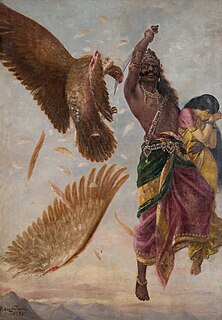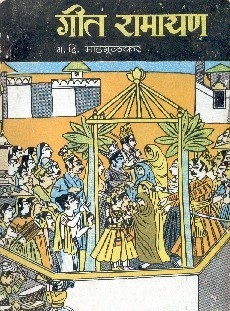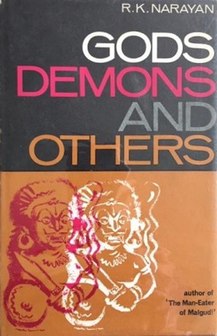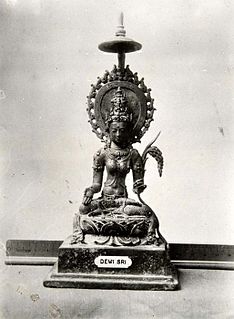 W
WDepending on the methods of counting, as many as three hundred versions of the
 W
WAdhyatma Ramayana is a 13th- to 15th-century Sanskrit text that allegorically interprets the story of Hindu epic Ramayana in the Advaita Vedanta framework. It is embedded in the latter portion of Brahmānda Purana. The Hindu tradition attributes the text to the Bhakti movement saint Ramananda.
 W
WAraṇya-Kāṇḍa or The forest episode is the third chapter of the epic poem Ramayana, written by Valmiki. It is also found in Rāmcaritmānas by Tulsidas.
 W
WAsura: Tale of the Vanquished is the first novel of Anand Neelakantan. It was published by Leadstart Publishing on 14 May 2012. This mythological fiction depicts the tale of Ramayana from the perspective of Ravana and a common Asura, Bhadra.
 W
WGeet Ramayan is a collection of 56 Marathi language songs chronologically describing events from the Indian Hindu epic, the Ramayana. It was broadcast by All India Radio, Pune in 1955–1956, four years before television was introduced in India. Written by G. D. Madgulkar and the songs being composed by Sudhir Phadke, Geet Ramayan was acclaimed for its lyrics, music and singing. It is considered a "milestone of Marathi light music" and the "most popular" Marathi version of Ramayana.
 W
WGods, Demons and Others is a collection of short stories by R. K. Narayan adapted from Indian history and mythology, including epics like The Ramayana and Mahābhārata. In this book, Narayan provides both vitality and an original viewpoint to ancient legends.
 W
WKakawin Ramayana is an Old Javanese poem rendering of the Sanskrit Ramayana in kakawin meter.
 W
WKṛttivāsī Rāmāyaṇ,; also called Śrīrām Pãcālī, composed by the fifteenth-century Bengali poet Krittibas Ojha, from whom it takes its name, is a rendition of the Rāmāyaṇa into Bengali. Written in the traditional Rāmāyaṇa Pā̃cālī form of Middle Bengali literature, the Kṛttivāsī Rāmāyaṇ is not just a rewording of the original Indian epic, but also a vivid reflection of the society and culture of Bengal across the period of its circulation, from the Middle Ages into the modern period. It was characterised by Dinesh Chandra Sen in 1911 as 'by far the most popular book in Bengal' and 'the Bible of the people of the Gangetic Valley'.
 W
WRaghuvamsha is a Sanskrit mahakavya by the most celebrated Sanskrit poet Kalidasa. Though an exact date of composition is unknown, the poet is presumed to have flourished in the 5th century CE. It narrates, in 19 sargas (cantos), the stories related to the Raghu dynasty, namely the family of Dilipa and his descendants up to Agnivarna, who include Raghu, Dasharatha and Rama. The earliest surviving commentary written on the work is that of the 10th-century Kashmiri scholar Vallabhadeva. The most popular and widely available commentary, however, is the Sanjivani, written by Mallinatha (ca.1350-1450).
 W
WRama is a fictional character based on Hindu Avatar Rama published by DC Comics, and a potential love interest of Wonder Woman. He first appears in Wonder Woman #148 series 2,, and was created by Eric Luke and Yanick Paquette.
 W
WThe Ramakien is one of Thailand's national epics, derived from the Buddhist Dasaratha Jataka. Ramakien is an important part of the Thai literary canon.
 W
WRamavataram, popularly referred to as Kamba Ramayanam, is a Tamil epic that was written by the Tamil poet Kambar during the 12th century. Based on Valmiki's Ramayana, the story describes the life of King Rama of Ayodhya. However, Ramavatharam is different from the Sanskrit version in many aspects – both in spiritual concepts and in the specifics of the storyline. This historic work is considered by both Tamil scholars and the general public as one of the greatest literary works in Tamil literature.
 W
WRamayan 3392 A.D. is a comic book series published by Virgin Comics based upon the Ramayana. It is written by Shamik Dasgupta, the art is by Abhishek Singh, and it is a brainchild of Deepak Chopra and Shekhar Kapur. It features a re-imagining of the historical classic in a post-apocalyptic future.
 W
WRamayana is a retelling of the epic by C. Rajagopalachari. It was first published by Bharatiya Vidya Bhavan in 1957. This book is an abridged English retelling of the Valmiki Ramayana; he had earlier published a version of Kamba Ramayanam. Rajaji considered this book and his Mahabharata to be his greatest service to his countrymen.
 W
WThe Ramayana is a mythological book by R. K. Narayan. It was first published by Chatto and Windus, London in 1972. The book is a shortened, prose adaptation of the Tamil Kamba Ramayanam. In 1938, Narayan made a promise to his dying uncle that he would translate the Kamba Ramayana to English, however, he did not think about this promise until 1968 when he began work on this effort. He later wrote The Mahabharata, published in 1978.
 W
WRamcharitmanas, is an epic poem in Awadhi language, composed by the 16th-century Indian bhakti poet Tulsidas. The word Ramcharitmanas literally means "Lake of the deeds of Rama". It is considered one of the greatest works of Hindu literature. The work has variously been acclaimed as "the living sum of Indian culture", "the tallest tree in the magic garden of medieval Indian poetry", "the greatest book of all devotional literature" and "the best and most trustworthy guide to the popular living faith of the Indian people".
 W
WRamlila (Rāmlīlā) is any dramatic folk re-enactment of the life of Rama according to the ancient Hindu epic Ramayana or secondary literature based on it such as the Ramcharitmanas. It particularly refers to the thousands of Hindu god Rama-related dramatic plays and dance events, that are staged during the annual autumn festival of Navratri in India. After the enactment of the legendary war between Good and Evil, the Ramlila celebrations climax in the Dussehra night festivities where the giant grotesque effigies of Evil such as of demon Ravana are burnt, typically with fireworks.
 W
WReamker is a Cambodian epic poem, based on the Sanskrit's Ramayana epic. The name means "Glory of Rama".It is the national epic of Cambodia. The earliest mention of this epic's manuscript in Cambodia dated back in 7th century based on Veal Kantel inscription (K.359). While, the surviving text of Reamker dates from 16th century. Reamker adapts the Hindu ideas to Buddhist themes and shows the balance of good and evil in the world. More than just a reordering of the epic tale, the Reamker is a mainstay of the royal ballet's repertoire. Like the Ramayana, it is a philosophical allegory, exploring the ideals of justice and fidelity as embodied by the protagonists, King Rama and Queen Sita. The epic is well known among the Khmer people for its portrayal in Khmer dance theatre, called the L'khaon, in various festivals across Cambodia. Scenes from the Reamker are painted on the walls of the Royal Palace in Khmer style, and its predecessor is carved into the walls of the Angkor Wat and Banteay Srei temples. It is considered an integral part of Cambodian culture.
 W
WSri Ramayana Darshana is the most popular work and the magnum opus by Kuvempu in Kannada based on the Hindu epic Ramayana. It earned him many distinctions including the Sahitya Akademi Award and the Jnanapeeth award in 1967.